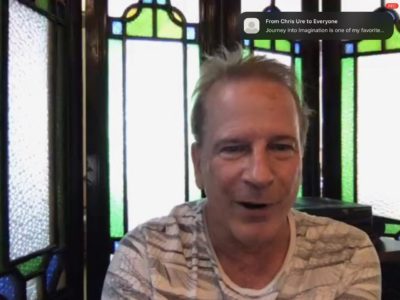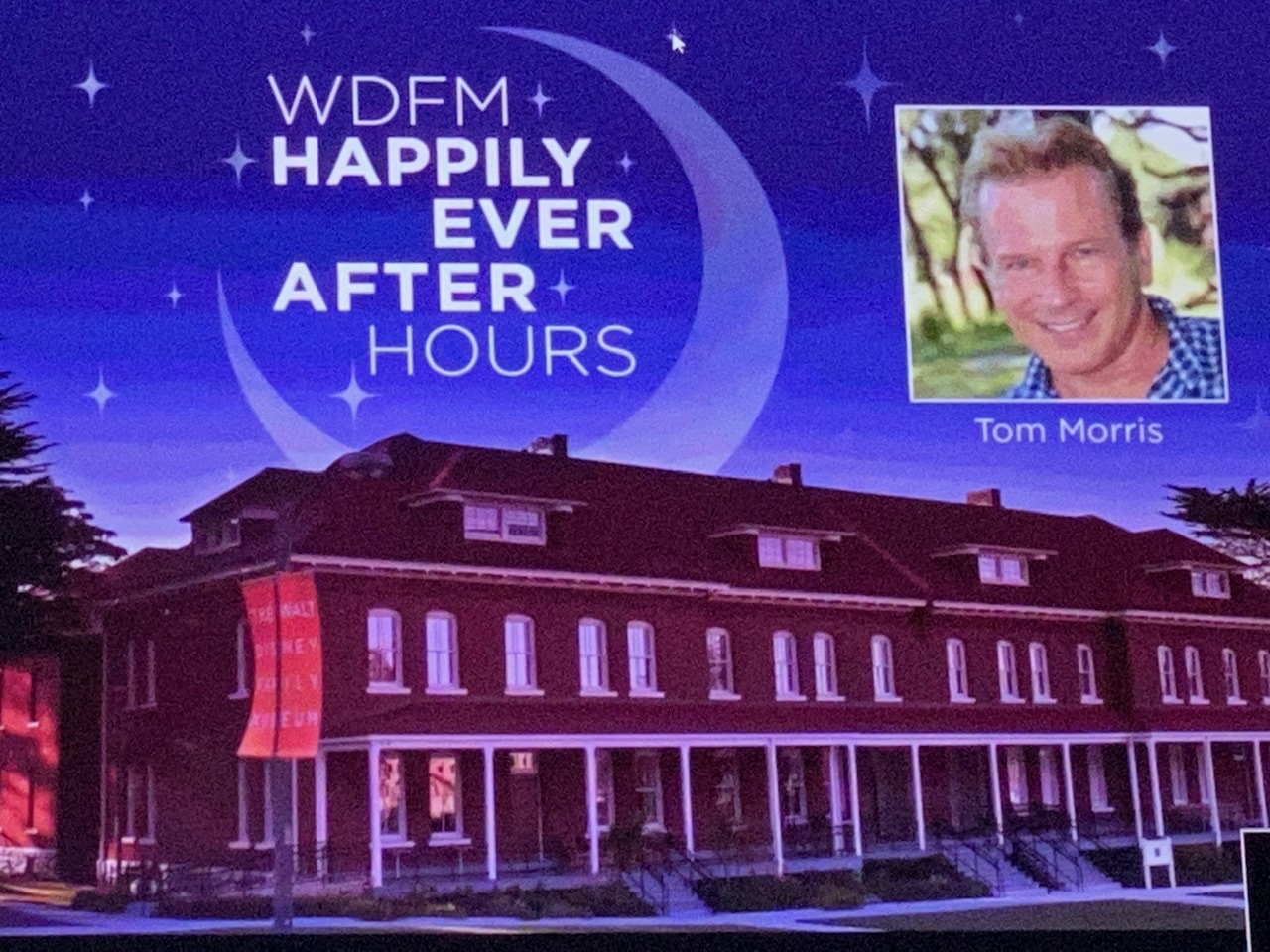
The Walt Disney Family Museum recently featured Tom Morris on a Happily Ever After Hours presentation. Tom Morris has had a career with Imagineering/WED Enterprises for about 30 years, and has worked on several parks and memorable attractions.
Morris discussed his beginnings as an Orange County California native with a paper route. This route let him meet Jack Sayers. Sayers helped land him a job at Disneyland at the age of 14 when it was more typical for 18 being the minimum age to work there. Thurl Ravenscroft of Haunted Mansion fame was another customer for the paper. Morris met Ravenscroft once while collecting subscription fees. He asked Ravenscroft if he was the singing bust in the Haunted Mansion to which Ravenscroft was impressed that there was a kid that knew about that.
While at Disneyland, Morris sold balloons on Main Street and in Fantasyland. All while he was working there and in high school he developed a drafting portfolio for three years. He presented the portfolio to WED when there was employment opportunities for the Florida Project. While in college, WED hired him as an apprentice, though pay cut to his Disneyland wages! It was his drafting portfolio that caught the eye of those hiring.
While in the early days of his career he got to work on EPCOT. His start was with the World of Motion attraction. Journey Into Imagination was more of a last minute project, as described by Morris. He was recruited by Tony Baxter to work on that attraction.
Morris was asked about working on EPCOT overall and how it felt to be on a project like it. He pointed out that the feeling around the company was that it was brand new and that they were “doing something positive for the world.” It also felt like an extension and in the spirit of Walt’s dream. At the time that brought a lot of idealism into the company. There was a huge belief that it was fulfilling Walt’s dream.
During the Q&A he was asked more about working on EPCOT and the difference between Walt’s original vision and what it came to be. Morris noted that the biggest difference was the original plan was for a community. Walt didn’t want to just do another Disneyland. The project was to be a large ground for experimenting for the betterment of man. He noted that Walt looked at Irvine in Orange County as it was being developed as a largely planned community. He pointed out that the largest contribution that the Florida Project was to have for humankind was better circulation of traffic. “It wasn’t about toasters…” meaning that the Project wasn’t just about future technology but how to help communities in a lasting way by planning better. EPCOT has still been an influence on communities in how it turned out. Morris shared that he has talked to sustainable design architects that say EPCOT was a large influence to their becoming designers in this way.
Morris was also asked about memories of opening Walt Disney World. Of all of them, what he remembers as impressive is the Monorail system and the scale of the resort. He was in awe of how everything was first linked to the Monorail and that it was spread out, yet people could travel on this transportation easily.
Besides EPCOT, Morris worked on many other projects for the parks. Among the notable contributions is the synchronized music for Space Mountain. This led to his working on Rock N’ RollerCoaster Starring Aerosmith. It all came about because of having a great sound system in his car and driving along the California coast around his home. He tried to sync what he was listening to with the road and realized it enhanced the travel. He found various music to take on a Walkman as he used a stopwatch to profile Space Mountain’s track. It wasn’t until he used John Williams’ ET score that it was sold to bring music to the iconic attraction. However, technology hadn’t caught up to what could be done because he found that there really was a difference in speed between riding in the morning and at night. Disneyland Paris’ Space Mountain brought about the technology to synchronize the music to the ride. Dick Dale was finally selected to provide the piece that would accompany the roller coaster. Morris feels that bringing music to an attraction like Space Mountain ties into the very roots of the company. It has been about syncing beautiful music to things like film and other early attractions. Space Mountain was another step in this.
After Space Mountain, Morris worked on the castle for Disneyland Paris. He noted that Parisian elementary school children had to study castles within the country and they couldn’t just do another realistic castle. Besides the artwork for Sleeping Beauty, Mont-Saint-Michel is another inspiration. That real French location has a village attached to the castle, and all beside the water on a rock. The Disneyland Paris castle is something designed to look like it’s floating on water because of Mont-Saint-Michel.
Another lasting park legacy he helped bring in was brought up in the question and answer time. Morris is responsible for the iconic Star Trader sign in Tomorrowland at Disneyland. He was in charge of both that facade and the Star Tours facade. Morris described being out of money in his budget because it all went to the Star Tours entrance. He didn’t want Star Traders to look like a generic shop, and found that neon signs were coming back into fashion. LA Neon came to WED to show various colors that were possible. Morris made a crude animation drawing of Mickey as an astronaut that Mark Henn cleaned up and finalized. It turned out this was all a cheap way of redoing the facade because they would not need to tear anything down on it! Disneyland leads loved it because it was an iconic fixture that would draw people into the shop from other parts of the land. While moving onto Disneyland Paris and eventually Hong Kong Disneyland he thought the Star Traders facade was long gone. When he finally returned to the park he was so surprised to see it still there! Although he pointed out that a mechanical drum was used as the system to animate the lights and now it is most likely more computerized.
Morris is currently writing and developing a book discovering voices of many who worked on Disneyland and Walt Disney World that are rarely recognized. It came about from wanting to write on the “archaeology of Disneyland” and found that known Imagineers would mention other people he’d never heard of. An example is Ted Rich that he found out was mostly responsible for New Orleans Square and Cinderella Castle. Rich was name dropped by quite a few Imagineers and Morris investigated all that he contributed. Others he found would start in WED or Imagineering and would become award-winning set designers for film. Some even worked on Disneyland as the final projects of their careers, as was the case for many set designers that worked on the Wizard of Oz.

The book will showcase photos that have never been seen outside of more private collections. It is to show both Walt and those that are seldom known to have worked on the theme parks. Among the more interesting things he discovered was that there was not really a backlot to the studio before Disneyland. It was WED Enterprises that created and designed the buildings after Disneyland. The Zorro television series was a great contributing factor to all of that where that show was how WED was created, but because of a delay they switched to working on a theme park to sit next to the studio! When Disneyland was completed they created the Western sets used for the Zorro television show.
This was a delightful and interesting presentation from an amazing Imagineer. Morris had so many stories to share that it could not be contained within the Happily Ever After Hours time frame. It was easy to tell he has loved working for Disney and still enjoys being part of the magic in some way. At one point he said that because he has ridden rides like Space Mountain so many times his perspective of it is different than the average guest. But he was quick to point out he still enjoys riding, especially that anything with music can give goosebumps and it’s important to have that to make the ride enjoyable again and again.
The Happily Ever After Hours has been a nice respite from this season where it has taken a long time for venues to reopen. There are more of these virtual presentations on the calendar, and I would recommend donating or becoming a member to be able to have more guarantee to watch. It has been a delightful look at the behind the scenes and legacy of such great figures as Walt Disney and Jim Henson.


Leave a Reply